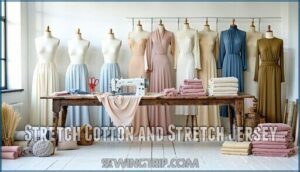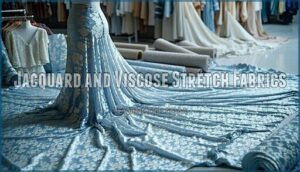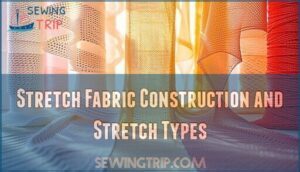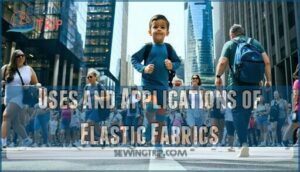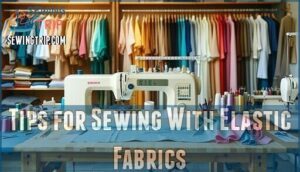This site is supported by our readers. We may earn a commission, at no cost to you, if you purchase through links.
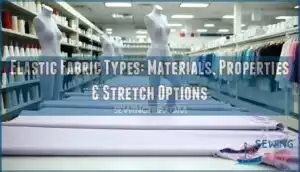
Understanding elastic fabric types unlocks the power to choose materials that perform exactly how you need them, whether you’re designing athletic gear that moves without restriction, sewing garments that actually fit, or selecting upholstery that won’t sag after a year.
The difference between spandex blends, stretch cotton, and 4-way knits isn’t just technical jargon—it’s the gap between fabric that works with your body and fabric that fights against it.
Table Of Contents
Key Takeaways
- Elastic fabrics are engineered textiles containing synthetic fibers like spandex, elastane, or Lycra (all chemically identical) that stretch up to 500% and recover their original shape through coiled polymer chains that unwind under tension and recoil when released.
- The construction method determines performance: 4-way stretch fabrics extend both horizontally and vertically with superior recovery for activewear, while 2-way stretch moves in only one direction and shows less reliable shape retention.
- Successful sewing with elastic fabrics requires ballpoint needles to avoid tearing fibers, polyester thread for stretch compatibility, and flexible stitches like zigzag or stretch stitches that move with the fabric rather than restricting it.
- Elastic fabrics span far beyond activewear into medical textiles (compression stockings with 60% market share), home upholstery that resists wrinkles, and specialty applications where controlled stretch and recovery matter more than simple flexibility.
What Are Elastic Fabrics?
Elastic fabrics aren’t just materials that stretch—they’re engineered textiles that recover their original shape after being pulled or distorted. Understanding how these fabrics work and what makes them elastic comes down to the fibers woven into their structure.
Let’s break down the definition, mechanics, and most common elastic fibers you’ll encounter.
Definition and Key Properties
Elastic fabric is your ticket to freedom of movement—a textile engineered with synthetic fibers like lycra, spandex, or elastane that stretch under tension and snap back to their original dimensions when you let go.
These elastic materials deliver three critical properties:
- Stretch recovery – the fabric’s ability to bounce back without sagging or losing shape
- Fabric density – tighter weaves hold elastic fibers securely for consistent performance
- Elastic properties – the percentage of stretch (usually 10-50%) determines your range of motion
Material science and textile technology combine to give you control over fit, comfort, and durability.
How Elastic Fabrics Work
The magic happens at the molecular level—elastic fibers are coiled polymer chains that unwind when you pull them and recoil like springs when the tension drops. Textile science calls this stretch recovery—your fabric’s ability to resist permanent deformation.
Fiber blending is where you take control: weaving elastane into cotton or nylon creates material dynamics that balance elastic properties with breathability, strength, or moisture-wicking. That’s how stretch fabric conforms to your body without losing its shape.
Common Elastic Fibers (Lycra, Spandex, Elastane)
Here’s the thing about those stretchy fibers—Lycra, spandex, and elastane aren’t three different materials competing for your attention; they’re the exact same synthetic polymer under different names. Lycra is DuPont’s trademarked brand, dominant in UK and Australian markets. Spandex—literally an anagram of "expands"—is the American term. Elastane prevails across Europe.
All three share identical elastane uses in fiber blending and spandex manufacturing, delivering outstanding lycra properties through identical elastic fiber production processes that make your stretch fabric snap back every time.
Types of Elastic Fabric Materials
Elastic fabrics aren’t one-size-fits-all—they come in dozens of material combinations, each engineered for different performance needs. You’ll find stretch properties in everything from cotton blends to synthetic mesh, and understanding what makes each one unique gives you control over your fabric choices.
Let’s break down the main types you’ll encounter and what sets them apart.
Stretch Cotton and Stretch Jersey
When you blend cotton’s breathability with elastane’s give, you get a fabric that moves with you instead of against you—perfect for everything from yoga pants to your favorite weekend tee. Stretch cotton preserves hypoallergenic properties while adding freedom of movement.
Jersey fabrics, with their knit textures and natural fabric drape, offer exceptional stretch recovery—bouncing back to shape after wear.
Whether you’re sewing with stretch fabrics or choosing cotton blends for activewear, these elastic fabrics combine comfort with durability that won’t quit on you.
Lycra, Spandex, and Elastane Differences
You’ll hear all three terms—Lycra, Spandex, and Elastane—tossed around like they’re different beasts, but they’re chemically identical synthetic fibers made from at least 85% polyurethane. Spandex dominates in the USA, elastane rules Europe and Asia, while Lycra is DuPont’s trademarked brand name.
All three deliver the same jaw-dropping stretch recovery—up to 500% extension without breaking—making them indispensable in performance wear and activewear where freedom matters most. Elastane makes skinny fit jeans more comfortable by moulding closer to the body and allowing ease of movement due to its high elasticity properties.
Mesh, Tulle, and Lace
Mesh, tulle, and lace break free from traditional fabric boundaries. Each one pairs delicate structure with stretch fibers to give you breathable, form-fitting materials that move without restricting.
Stretch lace combines intricate lace patterns with elastane for lingerie and overlays, while stretch tulle adds lightweight mesh textures to underlays.
These stretch trims offer airflow through micro-gaps, making them perfect when you need coverage that won’t cage you in.
Jacquard and Viscose Stretch Fabrics
Jacquard and viscose stretch fabrics deliver woven patterns with a backbone of stretch, combining artistic texture with mechanical give that lets you wear complexity without compromise.
Viscose jacquard uses fabric weaving techniques to embed jacquard designs directly into the material, while textile dyeing locks in color depth.
Viscose blends with elastane create stretch patterns that drape beautifully, making these stretchy fabrics ideal when you want visual drama that moves with you.
Neoprene, Nylon, and Other Blends
Neoprene, nylon, and their hybrid cousins bring rubber-like resilience and synthetic toughness to the table—think of them as the armor-plated athletes of the stretch fabric world.
Neoprene blends trap heat while flexing, making them perfect for wetsuits and protective gear. Nylon fabrics mixed with elastane create elastic composites that won’t quit—textile hybrids engineered for durability.
These synthetic materials turn stretchy fabrics into performance machines you can push hard without consequence.
Stretch Fabric Construction and Stretch Types
Not all stretch fabrics are created equal—the way they’re constructed determines how they move and where they excel. Understanding the difference between 2-way and 4-way stretch, knit versus woven construction, and how elastic yarns are actually made will help you choose the right material for your project.
Let’s break down the mechanics behind the stretch.
2. Way Vs. 4-Way Stretch Fabrics
When you’re choosing stretch fabric, understanding the difference between 2-way and 4-way stretch gives you control over your project’s performance. Here’s what separates them:
- Stretch direction: 2-way stretches in one direction (warp or weft), while 4-way extends both horizontally and vertically for greater fabric stretchability.
- Fabric recovery and elastic durability: 4-way stretch returns to its original shape after stretching, whereas 2-way doesn’t bounce back as reliably.
- Applications: You’ll find 2-way in casual wear, but 4-way dominates sportswear where tensile strength and elasticity matter.
Choose 4-way for activewear where stretch limits are tested. Understanding fabric stretch properties is essential for selecting the right fabric.
Knit Vs. Woven Elastic Fabrics
The way your fabric is constructed—knitted loops or interlaced threads—determines whether it stretches with you or fights you at every move.
Knit fabrics use interlocking loops that create natural stretch in multiple directions, giving you excellent elastic recovery and higher stretch ratios. Woven elastic fabrics rely on a tighter fabric weave with elastic yarn woven in, offering controlled yarn tension but less freedom.
Knit patterns deliver the flexibility you need when movement can’t be compromised.
Elastic Yarn Manufacturing Process
Behind that stretch and recovery lies a manufacturing process where polymers are heated, extruded through tiny spinnerets, and twisted into yarns that won’t quit on you. Here’s how elastic yarn manufacturing breaks down the control you need over textile finishing and material sourcing:
- Polymer production creates the prepolymer foundation mixed with solvents for manipulation
- Fiber spinning forces material through spinnerets, transforming liquid into solid strands
- Heated solvent gas and nitrogen solidify the polymer into elastic textiles
- Yarn twisting bundles fibers together at varying thicknesses for different stretch ratios
- Textile finishing refines elastic fabric properties through dyeing and treatment processes
Uses and Applications of Elastic Fabrics
Elastic fabrics aren’t just stuck in your gym drawer—they’ve broken free into almost every corner of your life. From the clothes that move with you to the medical gear that aids recovery, these materials deliver flexibility where you need it most.
Let’s explore how stretch fabrics show up in fashion, function, and everything in between.
Fashion Apparel and Sportswear
You can’t conquer a marathon or nail a flowing midi dress without fabric that moves the way you do—that’s where elastic fabrics earn their place in fashion and sportswear. From athletic performance gear to figure-flattering dresses, stretchy clothing materials deliver a comfortable fit and fabric durability that keeps up with your boldest moves.
| Application | Fabric Type | Key Benefit |
|---|---|---|
| Activewear | 4-Way Stretch Jersey | Athletic Performance |
| Fashion Apparel | Stretch Cotton | Figure Flattering |
| Sportswear | Lycra Blends | Trendy Designs |
| Dancewear | Stretch Mesh | Comfortable Fit |
Undergarments and Medical Textiles
Beyond fashion-forward fits, elastic fabrics serve serious roles in undergarments and medical textiles where elastic recovery and health benefits matter most.
Spandex dominates medical applications with over 60% market share, powering compression stockings that boost circulation and post-surgical garments engineered for healing.
These elastic textiles blend nylon and spandex to deliver up to 107% elongation while maintaining consistent pressure—fabric innovation that’s transforming textile technology in healthcare and intimate apparel alike.
Home Decor and Upholstery
Elastic fabrics aren’t just clinging to your body—they’re reshaping your living space, too, turning rigid upholstery and home textiles into flexible, form-fitting designs that adapt to everyday use.
You’ll find stretch furniture covers that grip snugly around awkward corners, while fabric wholesale suppliers now stock elastic fabrics for bedsheets, curtains, and decorative accents that resist wrinkles and maintain tension.
Smart upholstery tips? Choose blended materials for fabric selection that balance durability with recovery—home decor that actually works with you.
Specialty and DIY Projects
Craft makers and costume designers treat elastic fabric like a blank canvas—one that bends, stretches, and snaps back with every wild idea you throw at it.
You can source wholesale fabric for DIY projects ranging from costumes and dancewear to sewing hacks involving fabric painting and home decor accents.
Crafting and sewing with elastic fabric means your designs move with intention, recovering their shape after you’ve pushed every boundary.
Tips for Sewing With Elastic Fabrics
Working with elastic fabrics doesn’t have to feel like wrestling a slippery opponent. You just need the right tools and techniques to keep stretch materials from fighting back.
Here’s what you need to master before your next project.
Choosing The Right Needle and Thread
When your sewing machine hits stretch fabric with the wrong setup, you’re fighting a losing battle—puckered seams and skipped stitches will wreck even the best material. You’ll need a ballpoint needle to slip between fibers without tearing, polyester thread for fabric stretch compatibility, and adjusted thread tension to prevent distortion.
Set your stitch length longer and test a zig zag stitch—these sewing techniques give your seams room to move.
Handling and Cutting Techniques
Stretch fabric fights back when you try to cut it—it curls, shifts, and pulls away from your scissors unless you pin it down and work smart. Here’s how you take control of elastic trimming and fabric cutting without losing your mind:
- Lay your stretch fabric flat on a cutting mat, weighting edges with pattern weights or pins to prevent rolling
- Use rotary cutters instead of scissors for cleaner cuts and less distortion when sewing with stretch fabrics
- Let the fabric relax for 24 hours before cutting to eliminate stress from the bolt
- Cut with ballpoint needle-sharp shears following the grain, not fighting it—stretch management demands respect for fiber direction
Sewing Stitches for Stretch Fabrics
The wrong stitch on elastic fabric is like driving with the parking brake on—you’ll move forward, but you’re wrecking something in the process. You need stretch stitching that moves with your fabric tension, not against it. Your sewing machine should use a ballpoint needle and these stitch options for elastic seams:
| Stitch Type | Stretch Capability | Best Application |
|---|---|---|
| Zigzag | High flexibility | Seams, hems |
| Stretch Stitch | Maximum elasticity | Activewear, swimwear |
| Twin Needle | Professional finish | Hems on jerseys |
| Overlock | Edge security | Seam finishing |
These sewing tips transform stretch fabric from frustrating to controllable—pick the right stitch, and you’ll own every seam when sewing with stretch fabrics.
Using Elastic Tapes and Blends
Adding elastic tape or blending in stretch fibers isn’t some bonus move—it’s your secret weapon for controlling exactly where and how much give your garment delivers. You can place elastic tapes at waistbands or cuffs to target stretch recovery without overloading the entire fabric with elastane.
Tape applications let you blend materials strategically—combining elastic yarn with stable weaving for athletic seams that hold shape while stretch fabric bends with you.
Frequently Asked Questions (FAQs)
Can I recycle elastic fabrics like elastane and spandex?
Recycling Elastane and Spandex remains tricky—most facilities can’t break down these synthetic fibers yet. However, Sustainable Materials innovation is pushing Fabric Recycling forward through chemical processes that separate Elastic yarn from blended fabrics, offering hope for Waste Reduction in tomorrow’s Green Manufacturing landscape.
What are the environmental impacts of using neoprene rubber in clothing?
Neoprene rubber creates significant environmental impact through petroleum-based production and non-biodegradable neoprene waste that contributes to rubber pollution.
You’ll find eco-friendly alternatives like natural rubber or sustainable materials reduce the environmental footprint in textile industry applications.
Are there any natural alternatives to synthetic stretchy fabrics?
You’re in luck—natural fibers like cotton elastane, bamboo fabric, and silk blends deliver stretch without going full synthetic. Organic textiles and stretch cotton prove you don’t need pure spandex to get that flexible, body-hugging fit you’re after.
How do I determine the stretchiness of a fabric before purchasing?
You’ll want to perform a simple Fabric Stretch Test: grab a swatch and pull it horizontally and vertically to check Elastic Recovery and Stretch Fabric behavior.
Material Thickness, Weave Density, and Fiber Composition—especially Elastane content in Stretchable Textiles—determine how Elastic fabrics perform.
Can stretchy fabrics be used for formal or professional attire?
Absolutely—modern Fashion Design has cracked the code on blending comfort with polish. Luxury Textiles now incorporate subtle Elastic Fabrics that maintain structure in Business Attire, from custom-fitted blazers to Evening Gowns, proving Professional Dress doesn’t mean sacrificing movement or fit.
How do I care for and wash elastic fabrics?
Like a well-tuned spring that loses its bounce if mishandled, elastic fabrics demand careful attention.
Always cold-wash your stretch fabrics using gentle cycles to prevent fabric shrinkage and color fading. Skip the high-heat dryer—air-drying techniques preserve elasticity best, keeping your elastic textile performing like new.
What fabrics blend best with elastic fibers?
Cotton, jersey, nylon, and polyester excel when blended with elastane or spandex. These fabric blends create material hybrids that balance breathability, durability, and stretch.
Fiber mixing transforms rigid textiles into elastic fabrics, perfect for activewear and everyday wear.
How long do elastic fabrics maintain their stretch?
Quality elastic fabrics are like marathon runners—built for endurance. With proper care, elastane and stretch textiles maintain excellent stretch recovery for years, though elastic fatigue gradually reduces elongation.
Material degradation accelerates with heat, chlorine, and frequent washing, so fabric durability depends heavily on how you treat them.
Can elastic fabrics be dyed or printed?
Yes, you can dye and print elastic fabrics using specialized dyeing techniques and printing methods designed for synthetic fibers. Elastic yarn manufacturing incorporates fabric finishing treatments that guarantee color fastness during the textile treatment process, preserving stretch properties throughout textile manufacturing processes.
Where can I buy quality elastic fabric wholesale?
You can find elastic fabrics at Fabric Wholesale Direct and similar online retailers offering wholesale prices. Bulk purchasing by the roll maximizes savings.
Explore wholesale markets and discount suppliers for competitive rates on stretch materials for various elastic fabric uses.
Conclusion
Choosing the wrong fabric isn’t just a minor setback—it’s the difference between performance and compromise. Now that you’ve navigated the landscape of elastic fabric types, you hold the blueprint for selecting materials that respond to movement, endure wear, and deliver exactly what you demand.
Whether you’re engineering garments that refuse to quit or crafting pieces that conform without complaint, you’re no longer guessing. You’re commanding textiles with precision, bending stretch and recovery to your will. That’s not just knowledge—it’s control over every fiber.
- https://www.treehugger.com/what-is-elastane-and-is-it-sustainable-5116805
- https://www.polyurethanes.org/en/what-is-it/
- https://theecohub.com/elastane-vs-spandex-whats-the-difference/
- https://www.aplombdancewear.com/blog/what-are-the-differences-between-elastane-spandex-lycra
- https://www.thecreativecurator.com/what-is-elastane-elastane-vs-spandex-vs-lycra/

